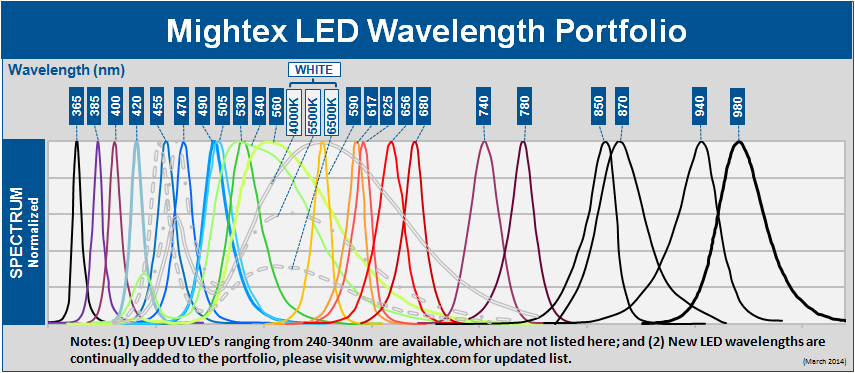With hundreds of scientific papers published by customers and several hundred product models to choose from, Mightex’s light sources (including LEDs and laser sources) are widely used in bioscience research, such as optogenetics, Calcium imaging, intrinsic imaging, cell biology, microfluidics, and voltage imaging etc.
When it comes to configuring the best illumination solutions for your research needs, you may follow the steps below:
Step-1: Choose the wavelength(s) which best fit your target application.
Depending on your specific research needs, you may want to choose a different illumination source from dozens of wavelengths (and hundreds of light source models) that Mightex has to offer. For ChR2 optogenetics experiment, for example, you may want to choose 480nm wavelength; while for red-shifted calcium imaging such as jRGECO1a, a longer-wavelength light (~560 nm) should be chosen instead. The diagram below shows the wavelength portfolio of Mightex’s LED sources. Other wavelengths (LEDs or lasers) may also be available if none of the wavelengths below meets your needs.

Step-2: Choose the right ‘beam format’ which best fit your optical system configuration.
Mightex’s world-class engineering team have developed a comprehensive portfolio of light sources with a wide range of ‘beam formats’, which enable you to configure the best optical illumination solution for almost any optical system that is required by your research needs. For example, collimated LEDs are usually necessary to fit into the infinity path of an optical microscope, while a fiber-coupled LED may be the best choice for freely-behaving optogenetics. In addition, Mightex has also developed a range of multi-wavelength or wavelength-switchable light sources if your research calls for more sophisticated light source solutions.
The table below shows a list of available ‘beam formats’ and their associated typical optical system configurations:
| Beam Format | Application or System Configuration Examples | Notes |
| Collimated | Microscope illumination |
|
| Uniform Illumination | Intrinsic imaging; Cell culture plate illumination | Provides uniform but not collimated illumination. |
| Fiber-Coupled | Freely-behaving optogenetics; Optical spectroscopy | Including both single- and multi-wavelength fiber-coupled LED sources |
| Lightguide-Coupled | Microscope illumination; Patterned DMD illumination; Intrinsic imaging | May be combined with a lightguide collimator to produce a “collimated & uniform” beam. |
Step-3: Choose the right LED driver.
IMPORTANT : (1) LED’s can ONLY be driven by a constant-current source, and NOT a voltage source (e.g. a battery, or a AC/DC power supply etc.); (2) Please always verify LED’s current rating first before choosing an LED driver, and please always make sure NOT to apply current that is above the LED’s current rating.
LED Inquiry Form
Fill out the form below and we will contact you!
"*" indicates required fields




